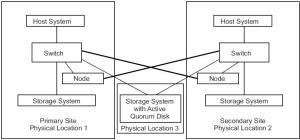The image above is a sample diagram of a stretched SVC configuration. It meets the most basic requirements needed for the configuration. Some of the key items of note are…
3rd Site Quorum Disk
SVC uses a concept of a quorum disk for maintaining cluster availability and storing configuration data. A small portion (couple hundred MBs) of configured storage is reserved for quorum space. In a give SVC cluster there is one active quorum copy, and two candidate quorum copies. In a normal SVC configuration the quorum disks (as they are called) are automatically configured on storage available to the SVC cluster. In a stretched SVC configuration the quorum selection must be controlled manually to ensure availability, which brings me back to the 3rd site quorum…
A stretched SVC configuration provides volume access across two sites. However a third separate site is deployed to act as a “witness” in the event of failure. Since we can’t have one active quorum disk (remember there is only 1 active, 2 candidate or backup disks) in two sites we place it at a third site. Should one of our two sites fail, the third site is available to coordinate automatic fail over.
A third site quorum is an important availability feature and the primary enabling technology for having automatic fail over between sites. A similar product addition was announced to be added to the EMC VPLEX product http://searchstorage.techtarget.com/news/2240035694/EMC-Vplex-expanded-for-active-active-storage-at-EMC-World-2011.
Last item to mention on third site quorums is the requirements for it are minimal. A DS3400 stuck in a storage closet can suffice.
High Available volumes – Volume Mirroring
SVC can do some cool things with volumes: non-disruptive migrations, conversions from/to thick/thin volumes, replication and FlashCopy and volume mirroring. Volume mirroring is utilized in a stretch SVC configuration to ensure that each site has a consistent copy of data. Hosts see a single volume, SVC maintains two copies of the data that makes up the volume. The volume mirror copies are setup so each site has a copy. A loss of a volume copy does not impact volume access, so storage can be taken offline for maintenance if needed.
Supported Configurations
A Stretched SVC configuration still supports all of the same external storage systems, host types, and host multipath software. I think that’s important to note…with some changes in your SVC configuration only, you can have an storage setup which gives you read/write access to a single volume(s) in two data centers at the same time.
In Part 3 I’ll tell you what you can do when you combine stretched SVC with VMware vSphere.


Pingback: Bridging datacenters with VMware vSphere and IBM SAN Volume Controller – Part 1 | virtualstoragespeak
Thanks for pointing out that vPlex has similar quorum disk reqs, I wasn’t clear on that myself.
Quorum or “witness disk” functionality was announced for VPLEX at the recent EMC World, before that they did not have similar functionality. A site failure resulted in storage being “paused” until administrator intervention. The third site quorum requirement on the surface may be perceived as a pain, but it is important since it enables the automatic fail over.
Good articles … I’m in the middle of scoping a similar solution, so they’re very timely. Looking forward to the next in the series, and I’m sure you’re going to address HA limitations etc (8 host clusters max due to primary node limitations) but have you also got any definitive statements from VMware on their support stance for an SVC-style stretched cluster? I can’t find anything on this in the VMware KB, but there’s articles that reference the similar EMC VPLEX product (no surprise I guess).
FYI be aware of the following advisory https://www-304.ibm.com/support/docview.wss?uid=ssg1S1003782 entitled ‘Potential Loss of Access for Split Cluster Systems During Site Failure’ which can result is vdisks being offline at both sites if one site goes down. OUCH.
Hi vstig, I am planning on talking about the VMware setup and requirements. Stay tuned for further support information as well.
Looking forward to it.